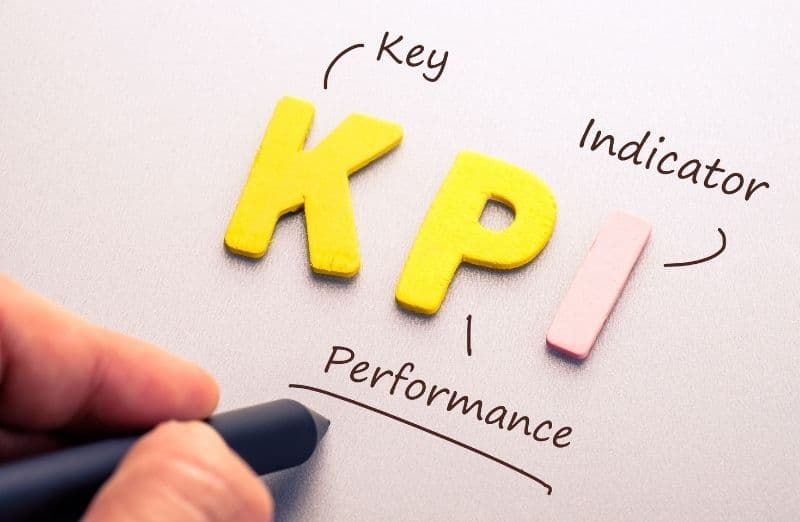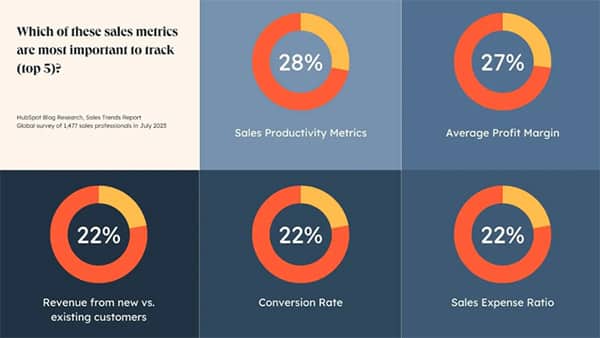Understanding the KPI Disconnect
Sales KPIs are created to help teams stay focused on what matters—calls, meetings, conversions, revenue. But here’s the reality check: many sales reps either ignore or quietly dismiss KPIs altogether. And when they do, performance drops, accountability fades, and results suffer.
This isn’t a people problem. It’s a system problem. And the solution lies in how we present, track, and motivate teams to engage with their KPIs daily. Utilizing customer relationship management software can help track and motivate engagement with KPIs by creating dashboards to monitor key metrics, assess sales funnels, and convert leads into customers.
What Are Sales KPIs and Why They Matter
Sales KPIs (Key Performance Indicators) are measurable values that show whether sales goals are being met. Think:
- Calls made
- Emails sent
- Demos booked
- Deals closed
- Pipeline health
- Average purchase value: This metric represents the average amount each customer spends on products or services. It is significant for developing sales strategies to increase revenue from existing customers, providing insights into consumer behavior, and assisting companies in forecasting potential earnings.
- Customer lifetime value: This metric is critical for understanding how much revenue a company can expect from its customers over the entirety of their relationship. It aids in measuring sales performance, identifying profitable customer segments, and developing strategies to enhance customer retention and revenue through upsells and cross-sells.
They guide daily action and tie rep activity to company growth. But only when people pay attention to them.
What Sales KPIs Really Mean (and Why They Matter)
Sales KPIs (Key Performance Indicators) are essential metrics that sales teams use to track progress toward objectives and broader business goals. These indicators help assess the effectiveness of a sales strategy and determine whether sales activities are working or if a new approach is needed. Key metrics include sales volume, sales growth, and customer acquisition cost.
By focusing on these KPIs, sales teams can identify areas for improvement and optimize their sales process. For instance, tracking customer acquisition cost helps in understanding the efficiency of your sales strategy in acquiring new customers, while sales growth metrics provide insights into the overall health and trajectory of your sales efforts.

Impact on Sales Performance
Sales KPIs have a significant impact on sales performance. By tracking the right metrics, sales teams can identify trends and patterns in sales data, enabling them to make data-driven decisions about their sales strategy. This optimization of the sales process ensures that efforts are focused on activities that drive results.
Additionally, KPIs allow for the tracking of individual sales reps’ performance as well as the overall sales team’s performance. This visibility helps sales leaders pinpoint areas needing improvement and provides a basis for targeted coaching and training. For example, if a sales rep consistently falls short on closing deals, a sales leader can provide specific training to improve their closing techniques, thereby enhancing overall sales performance.
Signs Your Sales Team is Ignoring Key Performance Indicators
- Reps aren’t logging activity in CRM: This can indicate a lack of engagement or understanding of the importance of tracking sales activities. Without proper logging, sales managers lose visibility into the sales process, making it difficult to assess the sales team’s performance accurately.
- Weekly targets are missed with no urgency: When sales reps consistently miss their targets without feeling a sense of urgency, it suggests a disconnect between the sales goals and the team’s motivation. This lack of urgency can lead to a decline in sales performance and a failure to meet sales targets.
- Manager 1:1s focus on excuses, not metrics: If one-on-one meetings between sales managers and reps center around excuses rather than analyzing metrics, it indicates a shift away from data-driven performance evaluation. This can prevent the identification of areas for improvement and hinder the development of effective sales strategies.
- There’s confusion or apathy around expectations: When sales reps are unclear about what is expected of them or show little interest in meeting expectations, it reflects a misalignment between the sales team’s goals and the company’s objectives. This confusion can lead to inconsistent sales efforts and a lack of focus on key performance indicators.
- KPI dashboards are collecting digital dust: If the KPI dashboards are not being actively used or referred to, it suggests that the sales team is not prioritizing the tracking of key performance indicators. This neglect can result in missed opportunities to optimize sales processes and improve sales outcomes.
- Low customer retention rates: A decline in customer retention rates can be a sign that the sales team is not effectively engaging with existing customers or addressing their needs. This can lead to increased customer churn and a negative impact on the company’s revenue growth.
Ignoring KPIs is often subtle but deeply damaging. By recognizing these signs, sales leaders can take proactive steps to re-engage their teams with key performance indicators and align sales strategies with
Root Causes of KPI Ignorance
Let’s unpack why sales teams sidestep metrics:
- Lack of clarity: When KPIs are not clearly defined or communicated, sales reps may struggle to understand their importance or how they relate to their daily tasks. This lack of clarity can lead to confusion and disengagement, as reps may not see the connection between their efforts and the company’s goals.
- Poor feedback loops: Without timely and constructive feedback, sales reps may feel disconnected from their performance metrics. This can result in a lack of motivation to track and improve their KPIs, as they may not see the immediate benefits of their efforts.
- Overcomplicated tracking tools: Complex or cumbersome tracking systems can discourage reps from engaging with KPIs. When tools are difficult to use or require excessive manual input, reps may avoid using them altogether, leading to a disconnect between sales activities and performance metrics.
- No visible rewards for hitting targets: When sales reps do not receive recognition or incentives for achieving their KPIs, they may lose motivation to strive for those targets. Visible rewards, such as bonuses or public recognition, can encourage reps to focus on their KPIs and drive better performance.
- Burnout or disengagement: High-pressure environments and relentless targets can lead to burnout, causing sales reps to disengage from their KPIs. When reps are overwhelmed, they may prioritize immediate tasks over long-term performance metrics, resulting in a lack of focus on key indicators.
- Neglecting existing customers: Sales teams may become overly focused on acquiring new customers, neglecting the importance of nurturing relationships with existing ones. This can lead to a decline in customer retention rates and a failure to leverage the full potential of the customer base.
Without motivation and meaning, KPIs become noise. Sales managers and leaders must create an environment where KPIs are seen as valuable tools for growth and success, rather than burdensome obligations. By addressing these root causes, companies can foster a culture of engagement and accountability, where sales reps are motivated to track and achieve their KPIs.
The Psychology Behind Avoiding Metrics

Reps don’t avoid KPIs because they’re lazy. They do it because:
- Metrics feel disconnected from their daily reality: Sales reps often perceive KPIs as abstract numbers that don’t directly relate to their day-to-day tasks. This disconnect can make it challenging for them to see how their efforts contribute to the broader company goals, leading to a lack of engagement with these metrics.
- There’s fear of being judged: KPIs can sometimes feel like a tool for scrutiny rather than improvement. Sales reps may fear that their performance will be judged harshly based on these metrics, which can create anxiety and lead to avoidance behaviors.
- Goals seem unreachable: When KPIs are set too high, they can feel unattainable. This perception can discourage sales reps from striving to meet these goals, as they may feel it’s impossible to achieve them, leading to disengagement.
- There’s no dopamine hit from meeting them: Unlike immediate rewards, such as closing a deal or receiving a bonus, KPIs often lack instant gratification. The absence of a quick dopamine hit can make it difficult for sales reps to stay motivated to track and achieve these metrics consistently.
- Long sales cycle length can make KPIs feel overwhelming: Extended sales cycles can make it challenging for reps to see the immediate impact of their efforts on KPIs. This can lead to frustration and a sense of being overwhelmed, as the connection between their actions and the outcome becomes less apparent.
Gamification addresses all of these issues by turning measurement into motivation. By incorporating elements of play, such as points, badges, and competitions, gamification provides immediate feedback and rewards, making the process of tracking KPIs more engaging and less daunting. This approach not only helps to bridge the gap between daily activities and broader goals but also reduces the fear of judgment by focusing on progress and achievement, rather than just outcomes.
When KPIs Feel Like Micromanagement
KPIs should empower, not suffocate. But when reps feel watched instead of supported, they disengage. A sales manager can help mitigate this feeling by providing support and guidance.
Gamification reframes this dynamic. Instead of “you must,” it becomes “you win when…”
The Gap Between Activity and Ownership
Ownership only happens when reps understand how their activity affects the bigger picture. Gamification tools like Spinify make this connection visible and rewarding. Effective sales strategies can help bridge the gap between activity and ownership.
KPI Fatigue: Too Much, Too Often
Overloading reps with 20 metrics leads to KPI fatigue. Focus on 3–5 impactful KPIs and gamify them to drive lasting behavior.
Additionally, concentrating on clear sales targets can help reduce KPI fatigue by aligning team efforts with specific performance goals, making it easier to assess and adjust strategies effectively.
Is It a Data Problem or a Motivation Problem?
Most companies have the data—they just lack the motivation framework to make it matter. That’s where gamification enters the chat.
Why Spreadsheets No Longer Cut It
Manual KPI tracking is outdated, slow, and disengaging. It’s time to evolve beyond Google Sheets and static reports.
Spinify automates KPI tracking and makes it visual, fun, and engaging.
The Role of Leadership in Sales Performance KPI Engagement
If your managers aren’t living and breathing KPIs, neither will your team. Leaders must celebrate wins, gamify goals, and model consistency. Sales managers play a crucial role in driving KPI engagement by providing the right tools and content for sales reps, monitoring metrics, and ensuring effective coaching and training.

Spinify gives leaders real-time insight and coaching tools to drive accountability.
What Reps Really Think About Sales Data KPIs (Data Insights)
📊 According to Salesforce’s “State of Sales,” only 32% of reps feel their KPIs are “very clear.”
📊 48% say they “don’t feel rewarded” for consistent KPI performance.
Gamification changes both of those stats—fast.
How Visibility Impacts Accountability
What gets seen gets done. When reps can track their own progress—and their peers’—they stay accountable.
Spinify’s live leaderboards and dashboards provide this visibility without extra admin work.
Why Quarterly Reviews Don’t Work
Waiting three months to give feedback is like telling a runner how they did after the race.
Spinify delivers real-time feedback, so reps adjust today—not next quarter.
The Problem with Passive Dashboards
Standard dashboards sit quietly in the corner—static, ignored, forgotten. Spinify transforms dashboards into dynamic, real-time motivators with visual alerts, celebrations, and coaching nudges.
No more passive metrics. It’s time for performance that speaks up. Dynamic dashboards can significantly improve sales team performance by tracking key performance indicators (KPIs) to measure progress and optimize sales cycles.
Challenges with Traditional KPI Tracking
Traditional KPI tracking methods can be limiting and may not provide a complete picture of sales performance. One of the main challenges is that these methods often focus on lagging indicators, such as sales revenue, rather than leading indicators, such as sales activity and customer engagement.
This focus on past performance can make it difficult for sales teams to identify areas for improvement and make proactive, data-driven decisions. Without real-time insights, sales teams may miss opportunities to adjust their strategies in response to market changes or evolving customer needs, ultimately impacting their sales performance.
Limitations of Traditional Methods
Traditional KPI tracking methods also have several limitations. For example, they may not take into account the complexity of modern sales processes, which often involve multiple stakeholders and touchpoints. This complexity requires a more nuanced approach to tracking and analyzing sales performance.
Additionally, traditional methods may not provide real-time data, which can make it difficult for sales teams to respond quickly to changes in the market or customer needs. Without timely insights, sales teams are left reacting to issues after they have already impacted performance, rather than proactively addressing them.
Gamification: A Modern Solution to KPI Ignorance
Gamification takes traditional KPI tracking and wraps it in engagement. It connects effort with achievement using:
- Points
- Badges
- Competitions
- Visual progress
And the results? Skyrocketing rep motivation and KPI adherence. Additionally, gamification can lead to sustainable revenue growth by aligning sales strategies with company goals and enhancing customer satisfaction.
Behavioral Science Meets Sales Metrics
Gamification is backed by real science: Positive reinforcement, goal-setting theory, and intrinsic motivation are all baked into Spinify’s platform—boosting action by design, not by chance.
By leveraging these principles, gamification can significantly improve a sales team’s performance.
How Gamification Turns Boring into Engaging
KPI charts? Meh. But a live leaderboard showing who’s 2 points away from closing the week’s challenge? Now that’s exciting.
Spinify transforms everyday sales metrics into interactive, goal-driven experiences.
Real-Time Feedback: The Game-Changer
Imagine if every call, email, or closed deal immediately triggered an update, celebration, or nudge. That’s what Spinify does. Reps don’t wait for applause—they get it when it matters.
Recognition as a KPI Multiplier
Recognition is a powerful motivator. Spinify automates it.
Whether it’s “Top Dials of the Day” or “Biggest Closer This Week,” the platform highlights achievements in front of peers—boosting morale and driving repeat behavior.
How Spinify Gamifies Sales KPIs
Gamification is not just about adding a fun layer to sales processes; it’s about transforming how sales teams perceive and engage with their key performance indicators. By integrating game mechanics into KPI tracking, Spinify helps sales reps see their daily activities as part of a bigger, more exciting challenge. This approach encourages reps to take ownership of their performance metrics, fostering a sense of accomplishment with each milestone reached.
Moreover, by visualizing KPIs in real time, Spinify provides immediate feedback, which is crucial for maintaining motivation and focus. Sales reps can see their progress and standings on leaderboards, creating a competitive yet supportive environment that drives performance. This transparency not only boosts morale but also enhances accountability, as reps are consistently aware of where they stand relative to their peers.
Spinify lets you gamify KPIs like:
- Calls made
- Emails sent
- Demos booked
- Proposals sent
- Deals closed
- Pipeline size
All pulled directly from your CRM and visualized beautifully in real time.
Additionally, Spinify’s gamification of KPIs aligns with broader company goals by ensuring that every tracked metric contributes to the overall sales strategy. This alignment helps sales teams focus on activities that directly impact revenue growth and customer satisfaction, ultimately leading to better sales outcomes. By turning mundane tasks into engaging missions, Spinify transforms the sales process into a dynamic and rewarding experience, encouraging reps to strive for excellence in every interaction.
Creating Custom KPIs That Reps Actually Care About
Not every team is the same. Spinify allows custom KPI creation, so you’re tracking what truly matters for your goals—and your people.
Whether it’s time-to-close or outreach variety, you call the shots.
Building Team Buy-In Through Gamified Competitions
When reps help build the game, they play harder.
Spinify encourages collaborative challenge design, making reps part of the process—and more committed to the outcome.
From Metrics to Missions: Reframing the Purpose
KPI tracking often feels like surveillance. But gamification reframes it into missions with clear objectives, feedback, and rewards. That change in framing boosts buy-in and performance.
Motivating Through Micro-Wins
Big goals can feel overwhelming. Spinify breaks down progress into micro-wins that spark momentum. Every call or step forward gets celebrated, not buried.
Spinify’s Role in Building Habitual Success
Habits form through repetition and reward. Spinify reinforces daily success with real-time rewards, badges, and visible streaks—turning KPIs into rituals.
Using Leaderboards Without Creating Anxiety
Spinify’s leaderboards are customizable—so you can reward improvement, consistency, or teamwork, not just “top closers.” This keeps competition healthy and inclusive.
AI Coaching and KPI Accountability
AI is changing how we coach. Spinify’s AI Coaching Agent analyzes rep behavior and gives personalized coaching prompts based on real KPI trends.
Coaching is no longer a time-consuming chore—it’s automated, smart, and scalable.
Spinify’s AI Coaching Agent in Action
Spinify’s AI Coaching Agent is a revolutionary tool that leverages artificial intelligence to provide real-time, personalized coaching prompts to sales reps. By analyzing individual performance data, the AI Coaching Agent identifies areas where reps can improve and offers timely suggestions to enhance their sales techniques and strategies. This approach ensures that coaching is not only effective but also scalable, allowing sales leaders to support their teams without dedicating excessive time to manual coaching efforts.
Examples of AI coaching prompts:
- “Looking at your recent performance metrics, what factors do you think have contributed to your current ranking in both the Sales Sprint Showdown and Sheets Test competitions?”
- “Looking at your recent performance of 84 leads against a target of 120, what strategies could help you bridge this gap?”
These timely nudges keep reps aligned and engaged, bridging the gap between data insights and actionable steps. The AI Coaching Agent empowers sales reps to take ownership of their performance by providing them with the tools and guidance they need to succeed. This proactive approach to coaching fosters a culture of continuous improvement, where sales reps are motivated to refine their skills and achieve their KPIs consistently.
By integrating AI-driven insights with gamification elements, Spinify’s AI Coaching Agent transforms traditional coaching methods into dynamic and interactive experiences. This not only enhances the overall sales team performance but also contributes to a more engaging and rewarding work environment. Sales reps receive immediate feedback and recognition for their efforts, which boosts morale and drives sustained performance improvements.
Incorporating AI coaching into the sales process helps sales leaders ensure that their teams are always on track to meet their goals, while also providing the flexibility to adapt to changing market conditions and customer needs. This innovative approach to sales coaching and KPI tracking positions Spinify as a leader in the field, offering a comprehensive solution for companies looking to boost their sales performance through technology and gamification.
What Gets Measured… Can Be Celebrated
KPIs don’t need to be cold metrics. With Spinify, every data point becomes a chance to recognize, reward, and repeat success.
Tracking KPI Progress Without Manual Input
Manual data entry kills motivation. Spinify connects with your CRM (Salesforce, HubSpot, Pipedrive, and more) to track progress automatically.
This reduces admin burden and keeps the focus on selling.
Reinforcing Goals with Visual Engagement
Humans are visual. Spinify’s progress bars, team heatmaps, and TV dashboards tap into that—making KPI tracking intuitive and attention-grabbing.
Avoiding KPI Overload with Smart Gamification
More KPIs doesn’t equal better performance. Spinify helps you focus on the right few metrics, gamified in meaningful ways that avoid burnout and overwhelm.
How to Implement Gamification Without Resistance
Start small. Use a pilot leaderboard. Get team input. Highlight early wins.
Spinify offers rollout support and best-practice templates to make the launch smooth and successful.
Implementing Gamification for KPI Tracking
Gamification is a powerful way to engage sales teams and improve KPI tracking. By setting up a gamified KPI tracking system, sales leaders can encourage their team members to focus on the metrics that matter most and provide a fun and competitive way to track progress.

Gamification transforms the often mundane task of KPI tracking into an engaging activity, where sales reps are motivated to achieve their targets through points, badges, and competitions. This approach not only makes KPI tracking more enjoyable but also fosters a culture of continuous improvement and healthy competition within the sales team.
Setting up a Gamified KPI Tracking System
To set up a gamified KPI tracking system, sales leaders should start by identifying the key metrics that they want to track. These metrics should be aligned with the company’s overall business goals and should be specific, measurable, achievable, relevant, and time-bound (SMART). Next, sales leaders should set up a system for tracking and displaying these metrics, such as a leaderboard or dashboard.
This visual representation helps keep the team engaged and aware of their progress. Finally, sales leaders should establish rewards and incentives for team members who meet or exceed their KPI targets. This can include things like bonuses, recognition, or privileges. By creating a system that rewards achievement and progress, sales leaders can drive higher engagement and better performance from their teams.
Transform Your KPIs with Spinify
If your sales team is ignoring KPIs, the answer isn’t more reports—it’s better engagement.
Spinify turns goals into games, metrics into motivation, and numbers into achievements your team actually cares about.
🚀 Ready to turn your KPIs into performance fuel?
Book a Spinify Demo Now and start building a culture that celebrates what matters.





